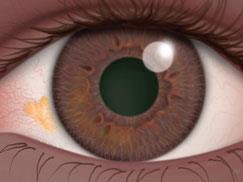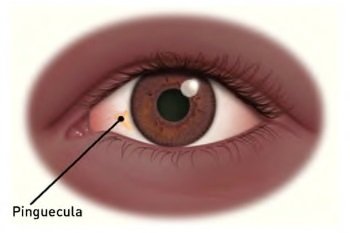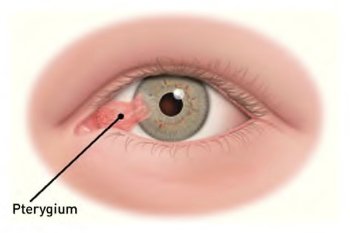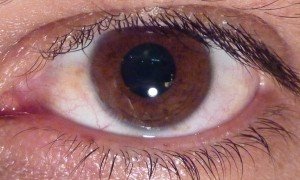
Have you looked at your eyes closely? You might be as surprised as I was.
It all started a couple of months ago. I was constantly having a feeling of very dry eyes and sometimes felt like I had something stuck in my eye. When looking at the mirror, instead of clean, white sclerotic tissue (the white part of the eye) I was faced with a yellowish, blood-shot sight of the tissue surrounding my iris.
Not only the feeling was annoying, but I looked like some sort of radiation-damaged zombie. I have known for a long time that a quick “pick-me-up” beauty trick is to use eye drops that reduce redness*, making the sclera look clear white, which in turn makes the eyes look brighter and the eye color to stand out.
*Note: The drops I am talking about are those with Nafazolin, a chemical agent that reduces redness by causing constriction in the arterioles of the eye. For some reason, this kind of eye drops don’t seem to exist in Germany; or at least, every time I had tried going to a pharmacy and asking for them no one seems to get what I am talking about, and end up handing me some regular lubricating drops. I usually import mine from Mexico, thus, since here you can buy them over the counter pretty much anywhere.
However, while the eye drops helped with the redness, the overall yellowish tint of my eye didn’t go away. “What is this?” I wondered, and upon closer inspection, I noticed that I even had a clearly defined line between the area of my eye that is usually exposed and the one that normally stays under the eyelids (which was still pristine white). It was as clear cut as a tan line.
My concern grew even bigger when in an even closer inspection, I actually noticed a cluster of some weird yellowish tissue growing on the corner of my eye between the lacrimal and the iris. WHAT THE HELL IS THIS? Some parasite? Degenerative disease? Is this reversible? Am I stuck with this forever? Will I go blind? Oh, so many questions flew through my mind at that moment.
Then I did what any millennial would do in that situation: Ask Dr. Google. According to WebMD, which is like a medical version of one of those choose-your-own-adventure books where everything ends in cancer, my symptoms seemed to match something called pinguecula or pterygium.
What are pinguecula/pterygium and what are their symptoms?
A pinguecula (plural pingueculae) is a small growth of tissue on the sclera of the eye, usually the size of a small lentil and of a yellowish coloration. It is made of a cluster of proteins, fat and calcium that form a little lump that usually appears near the inner corner of the eye (like in my case).

Pterygium is a condition in which such fleshy tissue from the conjunctiva, like the one forming the pinguecula, grows until it starts covering the cornea, in which case it might start to obstruct the patient’s vision. Pterygium is formed of tissue suffering from collagen degeneration and loss of elasticity. Common symptoms of it include dry eyes, foreign body sensation and irritation.

Pterygium is also known as “surfer’s eye”, since the condition seems to be correlated with heavy exposure to direct sunlight (especially UV radiation) and thus is relatively common between people that spend lots of time under the sun or live in areas close to the Equator (actually a lot of the scientific articles on the subject deal with its incidence in aboriginal tribes or African populations).
Should I be worried if I have it?
According to literature, while unpleasant and not very nice-looking, having a pinguecula or even pterygium is not harmful by itself.
While it is irreversible, it only becomes a problem if the wing-shaped, fleshy growth of tissue starts advancing towards the cornea and starts interfering with clear vision. However, up until this point it is not more than a cosmetic problem – so I guess I will have to learn to accept this flaw and live with it, taking better care of my eyes so the condition doesn’t advance into pterygium.

Even in the case of obstructive growth, not everything is lost. Surgery can be performed to remove the invading tissue and restore vision. Also, generally pterygium starts from a pinguecula, so you would have a “warning sign” for the condition before it gets out of control.
What can I do to avoid developing this condition (or to prevent it from worsening)?
From a quick review of the literature in the subject, seems like the most obvious advice would be to stay away from direct sunlight exposure as much as possible, and protect your eyes with suitable UV-protective gear every time you do outdoors activities.

However, in my case I think it is highly unlikely that I developed pingueculae due to excessive sun exposure. From age fifteen, I have been avoiding direct sunlight like the plague (to which I attribute my complete lack of facial wrinkles to this date), and I am the kind of person that applies sunscreen daily and wears huge sunglasses out. Also, I only noticed this condition recently, after several years of living in Germany, which is not a country that is characterized for its abundance of sunshine year-round, to put it mildly.
In my case, I suspect it had to do with the drastic increase in daily screen time that I had undergone in the past couple of years or so; especially in the past six months, I spend more time than ever writing or reading stuff on my computer, and on top of that I often read stuff on my phone for entertainment when I am out of the house – double whammy.
In fact, I could swear that my eyes were never the same after one time in one of those long transatlantic flights when I decided to read the entirety of Flow My Tears, The Policeman Said (a Philip K. Dick short novel) on my iPhone touch. From then on, I started to have lots of problems with dry eyes and blurry vision. Turns out that reading stuff on a tiny lit screen centimeters away from your face, in the dark, for hours at time, is bad for your vision… who would have known?
So, reduce conditions that could make your eyes strained or dry. Limit your screen time, avoid dusty conditions and use lubricating eye drops whenever needed. Learn from my mistakes!
Some other interesting facts about pingueculae and pterygium:
- It is a result of a combination between individual susceptibility and environmental exposure.
- Pterygium is twice as common in men as in women, and the incidence is greater in people between 20 and 40 years of age.
- People who wear glasses are affected by it less often.
- While direct exposure to UV radiation seems to be the main culprit, research points that reflected and scattered light might also play an important part.
- Smoking seems to have a protective effect against pterygium. Downside: it will increase your risk of pretty much everything else.
- In the case of excising the pterygium with surgery, there is still a re-incidence rate of 80%. Boomer.
Cheers,
Irime
---------------------------------------------------------------------------------
REFERENCES:
- What Is a Pinguecula and a Pterygium (Surfer's Eye)? - American Academy of Ophtalmology (https://www.aao.org/eye-health/diseases/pinguecula-pterygium)
- Clearfield et al., 2017. Conjunctival autograft for pterygium. Cochrane Database Syst Rev. (https://www.ncbi.nlm.nih.gov/pmc/articles/PMC5032146/pdf/nihms817163.pdf)
- Rim et al., 2017. Protective effect of smoking against pterygium development in men: a nationwide longitudinal cohort study in South Korea. BMJ Open (https://www.ncbi.nlm.nih.gov/pmc/articles/PMC5719276/pdf/bmjopen-2017-017014.pdf)
There is no need to worry much about this, it is extremely common condition of eye. pinguicula is present in almost everyone but size may vary and you will have to worry only if it hampers your vision and increases in size.... to relieve the symptoms Artificial tears are useful which are found OTC.
BTW nice info you have given. :)
Downvoting a post can decrease pending rewards and make it less visible. Common reasons:
Submit
Yh.. I really common in Africa and in areas where the high sunshine and dust.. As you said the surgery is very simple and is only indicated when vision and comfort is affected..
Downvoting a post can decrease pending rewards and make it less visible. Common reasons:
Submit
Thanks for the reassuring comment, @himal! Maybe it is a lot more common than initially thought, since I actually only noticed it when I was examining my eyes very closely. Perhaps for a lot of people it just goes undetected.
Artificial tears and eyedrops seem to help, indeed.
Downvoting a post can decrease pending rewards and make it less visible. Common reasons:
Submit
you are welcome @irime . Its always worrysome when a thing occurs to yourself how insignificant it is. As i was studying about pterygium in my medicine class i first noticed in my eyes but later on found its nothing sort of harmful. But studying about what it is and what is its sequale is always wise.
Downvoting a post can decrease pending rewards and make it less visible. Common reasons:
Submit
Yay, my smoking is finally paying off!
Downvoting a post can decrease pending rewards and make it less visible. Common reasons:
Submit
Hahaha!
Downvoting a post can decrease pending rewards and make it less visible. Common reasons:
Submit
Sorry to hear you've got this condition but at least its only cosmetic. Plus it adds a good personal touch to this post.
Its crazy that smoking protects against this. I suppose it has to do one good thing for all the bad it causes.
Downvoting a post can decrease pending rewards and make it less visible. Common reasons:
Submit
Yes, I was freaking out at first but at least I won't go blind from it (at least not if it stays the same way it is now).
Smoking does have some protective effects for some conditions (Parkinson's disease, for example), however we can agree that the risk/benefit balance is heavily skewed towards the dangerous side.
Downvoting a post can decrease pending rewards and make it less visible. Common reasons:
Submit
Ah... the human body. Literally every kind of tissue in our bodies can be afflicted in so many ways, only nature can come up with.
Your pinguecula is like the skin corn I had on my foot.
Stress-stimulus induced overgrowth of extracellular matrix deposits or cells...
Why are you doing that to us, bodies?
Hope, your thingy never develops into a pterygium.
Downvoting a post can decrease pending rewards and make it less visible. Common reasons:
Submit
Honestly, most of the time I am marveled at the fact that, while dealing with such complexity so (comparatively) few things ever go wrong!
Exactly, I think in my case this think was produced by some chronic friction stress due to dry eyes. I am certainly taking precautions to keep it in check!
Downvoting a post can decrease pending rewards and make it less visible. Common reasons:
Submit
Interesting! I have blue sclera so not used to white eyes, and I have a yellow part like what you mentioned, wonder if it is this or the sclera. Informative stuff!
Downvoting a post can decrease pending rewards and make it less visible. Common reasons:
Submit
If it looks yellowish and fibrous like a bundle of tissue, and won't go away after a good night's rest or using eye drops regularly, it is probably a small pinguecula. Thanks for your comment, @theactiveglutton!
Downvoting a post can decrease pending rewards and make it less visible. Common reasons:
Submit
My mom has had that same yellow thing next to her eye for years now and we haven't been able to figure out what it is. She goes every 6 months for an eye exam and no doctor has even mention anything to her. Thank you, thank you, thank you so much for this post!
Downvoting a post can decrease pending rewards and make it less visible. Common reasons:
Submit
I am very glad you found this helpful, @tshiuan! :-)
Downvoting a post can decrease pending rewards and make it less visible. Common reasons:
Submit
If i had that sh'' A puff of 420 for my eye and two puffs for me, No worries!
Downvoting a post can decrease pending rewards and make it less visible. Common reasons:
Submit
At least you would always be protected against the evil pingueculas/pterygium.
Downvoting a post can decrease pending rewards and make it less visible. Common reasons:
Submit
Thank you for your kindness to someone's eyes. I am glad to be able to join you in this steemit friend
Downvoting a post can decrease pending rewards and make it less visible. Common reasons:
Submit
Hope you enjoyed the read.
Downvoting a post can decrease pending rewards and make it less visible. Common reasons:
Submit
Wao.....really interesting. Never knew such condition existed. Great masterpiece.
Downvoting a post can decrease pending rewards and make it less visible. Common reasons:
Submit
Will be expecting more of this unique articles.... i have followed you
Downvoting a post can decrease pending rewards and make it less visible. Common reasons:
Submit
Me neither, I hope you found it interesting.
Downvoting a post can decrease pending rewards and make it less visible. Common reasons:
Submit
Yeah i really did...thanks for your upvote
Downvoting a post can decrease pending rewards and make it less visible. Common reasons:
Submit
pinguecula is also considered as precursor of pterygium. it is elastotic degeneration of collagen fibre coupled with hyaline deposition . pterygium should be differentially diagnosed from pseudopterygium. to prevent the recurrence of pterygium , now adays we prefer surgical excision with free conjuctival autograft [CLAU]. second surgical excision with amniotic membrane graft and mitomycin- C[MMC]
Downvoting a post can decrease pending rewards and make it less visible. Common reasons:
Submit
It is very common to see these conditions in my city of origin, Cumana - Venezuela. My city is coastal and the sun is relentless, which is why ophthalmologists recommend wearing sunglasses, hats and refreshing the eyes with artificial tears. The pterygium can be quite annoying when it completely invades the cornea because it limits vision. The good thing is that the pterygium is removed with a simple surgery. Greetings.
Downvoting a post can decrease pending rewards and make it less visible. Common reasons:
Submit